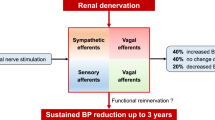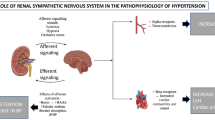Abstract
Purpose of Review
Renal sympathetic denervation (RDN) as treatment option for hypertension has a strong rationale; however, variable effects on blood pressure (BP) have been reported ranging from non-response to marked reductions in BP. The absence of a procedural end point for RDN is one of the potential factors associated with the variable response. Studies have suggested the use of renal nerve stimulation (RNS) to adequately address this issue. This review aims to provide an overview of the clinical and experimental data available regarding the effects of RNS in the setting of RDN.
Recent Findings
Animal studies have shown that high-frequency electrical stimulation of the sympathetic nerves in the adventitia of the renal arteries elicits an increase in BP and leads to an increased norepinephrine spillover as a marker of increased sympathetic activity and these effects of stimulation were attenuated or blunted after RDN. In a human feasibility study using RNS both before and after RDN, similar BP responses were observed. Moreover, in patients with resistant hypertension, RNS-induced changes in BP appeared to be correlated with 24-h BP response after RDN. These data suggest that RNS is a useful tool to identify renal sympathetic nerve fibers in patients with treatment-resistant hypertension undergoing RDN, and to predict the likely effectiveness of RDN treatments.
Summary
In acute procedural settings both in animal and human models, RNS elicits increase in BP and HR before RDN and these effects are blunted after RDN. Up to now, there is preliminary evidence that the RNS-induced BP changes predict 24-h ABPM outcome at follow-up in patients with resistant hypertension. Of note, studies are small sized and results of large trials comparing conventional RDN to RNS-guided RDN are warranted.
Similar content being viewed by others
Abbreviations
- ABPM:
-
Ambulatory blood pressure measurements
- BP:
-
Blood pressure
- DBP:
-
Diastolic blood pressure
- HR:
-
Heart rate
- RDN:
-
Renal nerve denervation
- RNS:
-
Renal nerve stimulation
- SBP:
-
Systolic blood pressure
References
Papers of particular interest, published recently, have been highlighted as: • Of importance
Wyss JM, Carlson SH. The role of the nervous system in hypertension. Curr Hypertens Rep. 2001;3(3):255–62. https://doi.org/10.1007/s11906-001-0048-0.
Kumagai H, Oshima N, Matsuura T, et al. Importance of rostral ventrolateral medulla neurons in determining efferent sympathetic nerve activity and blood pressure. Hypertens Res. 2012;35:132–41.
Esler MD, Krum H, Sobotka PA, Schlaich MP, Schmieder RE, Böhm M. Renal sympathetic denervation in patients with treatment-resistant hypertension (The Symplicity HTN-2 Trial): a randomised controlled trial. Lancet. 2010;376(9756):1903–9. https://doi.org/10.1016/S0140-6736(10)62039-9.
• Bakris GL, Townsend RR, Liu M, et al. Impact of renal denervation on 24-hour ambulatory blood pressure: results from SYMPLICITY HTN-3. J Am Coll Cardiol. 2014;64:1071–8. The first blinded, randomized, sham-controlled trial in the research regarding renal sympathetic denervation as treatment option for hypertension. The study failed to demonstrate a benefit of renal sympathetic denervation on reduction in 24-h ambulatory blood pressure measurements during follow-up.
• Townsend RR, Mahfoud F, Kandzari DE, et al. Catheter-based renal denervation in patients with uncontrolled hypertension in the absence of antihypertensive medications (SPYRAL HTN-OFF MED): a randomised, sham-controlled, proof-of-concept trial. Lancet. 2017; https://doi.org/10.1016/S0140-6736(17)32281-X. A recent published single-blind, randomized, sham-controlled trial showing proof op principle for BP lowering effect of RDN in patients with moderate hypertension, with a decrease of 5.5 [-9.1, -2.0]/4.8 [-7.0, -2.6] mmHg on 24-h ABPM at 3 months follow-up in the RDN group, whereas the BP in the control group remained unchanged.
Schlaich MP, Sobotka PA, Krum H, Lambert E, Esler MD. Renal sympathetic-nerve ablation for uncontrolled hypertension. N Engl J Med. 2009;361(9):932–4. https://doi.org/10.1056/NEJMc0904179.
Krum H, Schlaich M, Whitbourn R, et al. Catheter-based renal sympathetic denervation for resistant hypertension: a multicentre safety and proof-of-principle cohort study. Lancet. 2009;373(9671):1275–81.
Esler MD, Böhm M, Sievert H, et al. Catheter-based renal denervation for treatment of patients with treatment-resistant hypertension: 36 month results from the SYMPLICITY HTN-2 randomized clinical trial. Eur Heart J. 2014;35:1752–9.
Mahfoud F, Lüscher TF, Andersson B, Baumgartner I, Cifkova R, Dimario C, et al. Expert consensus document from the European Society of Cardiology on catheter-based renal denervation. Eur Heart J. 2013;34(28):2149–57. https://doi.org/10.1093/eurheartj/eht154.
Patel HC, Dhillon PS, Mahfoud F, Lindsay AC, Hayward C, Ernst S, et al. The biophysics of renal sympathetic denervation using radiofrequency energy. Clin Res Cardiol. 2014;103(5):337–44. https://doi.org/10.1007/s00392-013-0618-6.
Tzafriri AR, Keating JH, Markham PM, Spognardi AM, L. Stanley JR, Wong G, et al. Arterial microanatomy determines the success of energy-based renal denervation in controlling hypertension. Sci Transl Med. 2015;7(285):285ra65. https://doi.org/10.1126/scitranslmed.aaa3236.
Rimoldi SF, Scheidegger N, Scherrer U, et al. Anatomical eligibility of the renal vasculature for catheter-based renal denervation in hypertensive patients. JACC Cardiovasc Interv. 2014;7:187–92.
Persu A, Jin Y, Fe FEM, Jacobs L, Renkin J, Kjeldsen S. Renal denervation after Symplicity HTN-3: an update. Curr Hypertens Rep. 2014;16(8):460. https://doi.org/10.1007/s11906-014-0460-x.
• Chinushi M, Izumi D, Iijima K, et al. Blood pressure and autonomic responses to electrical stimulation of the renal arterial nerves before and after ablation of the renal artery. Hypertension. 2013;61:450–6. The first report on the use of electrical stimulation of the nerves surrounding the renal arteries aiming to identify the sympathetic nerve fibers. This canine model showed that before renal sympathetic denervation, electrical stimulation of the renal arteries induces a significant increase in blood pressure and these induced effects are blunted after renal sympathetic denervation.
Chinushi M, Suzuki K, Saitoh O, Furushima H, Iijima K, Izumi D, et al. Electrical stimulation-based evaluation for functional modification of renal autonomic nerve activities induced by catheter ablation. Hear Rhythm. 2016;13(8):1707–15. https://doi.org/10.1016/j.hrthm.2016.04.021.
Tsiachris D, Tsioufis C, Dimitriadis K, et al. Electrical stimulation of the renal arterial nerves does not unmask the blindness of renal denervation procedure in swine. Int J Cardiol. 2014;176:1061–3.
Sun J, Scherlag BJ, He B, et al. Electrical stimulation of vascular autonomic nerves: effects on heart rate, blood pressure, and arrhythmias. Pacing Clin Electrophysiol. 2015;38(7):825–30. https://doi.org/10.1111/pace.12603.
Sved AF, Ito S, Madden CJ. Baroreflex dependent and independent roles of the caudal ventrolateral medulla in cardiovascular regulation. Brain Res Bull. 2000;51(2):129–33. https://doi.org/10.1016/S0361-9230(99)00234-8.
Lu J, Wang Z, Zhou T, et al. Selective proximal renal denervation guided by autonomic responses evoked via high-frequency stimulation in a preclinical canine model. Circ Cardiovasc Interv. 2015;8:e001847.
Mizeres NJ. The anatomy of the autonomic nervous system in the dog. Am J Anat. 1955;96(2):285–318. https://doi.org/10.1002/aja.1000960205.
• Gal P, de Jong MR, JJJ S, Adiyaman A, Staessen JA, Elvan A. Blood pressure response to renal nerve stimulation in patients undergoing renal denervation: a feasibility study. J Hum Hypertens. 2015;29:292–5. The first human feasibility study using renal nerve stimulation before and after renal sympathetic denervation. The authors showed that renal nerve stimulation resulted in acute temporary blood pressure increase and this response was significantly blunted after renal sympathetic denervation.
• de Jong MR, Adiyaman A, Gal P, et al. Renal nerve stimulation–induced blood pressure changes predict ambulatory blood pressure response after renal denervation novelty and significance. Hypertension. 2016;68:707–14. This study showed in fourteen patients that the RNS-induced SBP rise before RDN was significantly correlated with changes in systolic ABPM at follow-up, suggesting that RNS can be potentially used as functional test to evaluate the efficacy and predict the clinical outcome of the RDN procedure.
de Jong MR, Hoogerwaard AF, Gal P, Adiyaman A, Smit JJJ, Delnoy PPHM, et al. Persistent increase in blood pressure after renal nerve stimulation in accessory renal arteries after sympathetic renal denervation novelty and significance. Hypertension. 2016;67(6):1211–7. https://doi.org/10.1161/HYPERTENSIONAHA.115.06604.
Nammas W, Airaksinen JKE, Paana T, Karjalainen PP. Renal sympathetic denervation for treatment of patients with atrial fibrillation: reappraisal of the available evidence. Heart Rhythm. 2016;13(12):2388–94. https://doi.org/10.1016/j.hrthm.2016.08.043.
Elvan A, Zipes DP. Right ventricular infarction causes heterogeneous autonomic denervation of the viable peri-infarct area. Circulation. 1998;97(5):484–92. https://doi.org/10.1161/01.CIR.97.5.484.
Booth LC, Nishi EE, Yao ST, Ramchandra R, Lambert GW, Schlaich MP, et al. Reinnervation of renal afferent and efferent nerves at 5.5 and 11 months after catheter-based radiofrequency renal denervation in sheep. Hypertension. 2015;65(2):393–400. https://doi.org/10.1161/HYPERTENSIONAHA.114.04176.
Chinushi M, Tagawa M, Sugiura H, et al. Ventricular tachyarrhythmias in a canine model of LQT3: arrhythmogenic effects of sympathetic activity and therapeutic effects of mexiletine. Circ J. 2003;67:263–8.
Oparil S, Sripairojthikoon W, Wyss JM. The renal afferent nerves in the pathogenesis of hypertension. Can J Physiol Pharmacol. 1987;65:1548–58.
Author information
Authors and Affiliations
Corresponding author
Ethics declarations
Conflict of Interest
The authors declare no conflicts of interest relevant to this manuscript.
Human and Animal Rights and Informed Consent
This article does not contain any studies with human or animal subjects performed by any of the authors.
Additional information
This article is part of the Topical Collection on Secondary Hypertension: Nervous System Mechanisms
Rights and permissions
About this article
Cite this article
Hoogerwaard, A.F., de Jong, M.R. & Elvan, A. Renal Nerve Stimulation as Procedural End Point for Renal Sympathetic Denervation. Curr Hypertens Rep 20, 24 (2018). https://doi.org/10.1007/s11906-018-0821-y
Published:
DOI: https://doi.org/10.1007/s11906-018-0821-y




